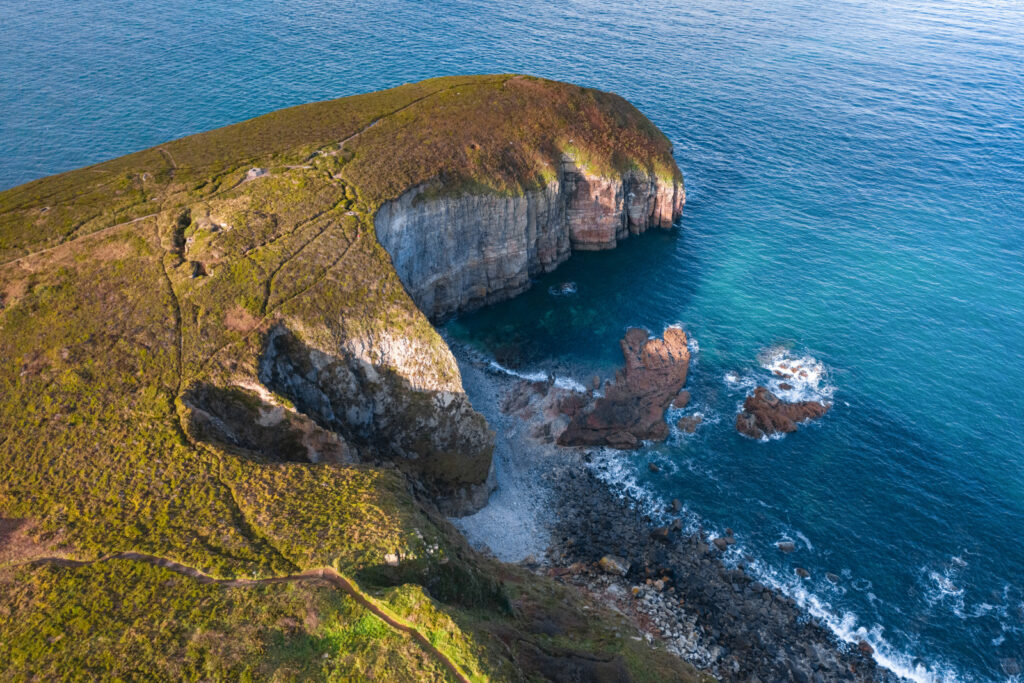
Cap Fréhel doesn’t draw visitors with a dreamy castle, a medieval town center, or a picturesque harbor. Its main attraction lies in nature itself. Few places in Brittany feature such dramatic cliffs plunging into the sea, rising up to 70 meters, these rock formations are a sight to behold.
On, behind, and in front of these towering cliffs unfolds a colorful spectacle. Rocks made of black shale, pink granite, and red sandstone mark the divide between land and sea. Especially at sunset, the stones glow in vibrant hues. In summer, the cliff edges bloom with purple heather, daffodils, and gorse. When the sun shines, the water shimmers emerald green—revealing why this stretch of coastline is known as the “Côte d’Émeraude” (Emerald Coast).
Hiking at Cap Fréhel: A Treat for the Senses
The view across the Gulf of Saint-Malo is spectacular not only on sunny days. When the weather is rough and the sea wild, you can feel the raw beauty of Brittany even more intensely at Cap Fréhel.
The best way to experience the area’s stunning landscapes and rich wildlife, the Cap Fréhel is a protected bird reserve, is along the hiking trails that follow the cliffs. These narrow paths are part of the GR 34 long-distance trail and can be quite rugged. Families with small children or elderly hikers should carefully consider whether to take on the challenge.
Popular starting or end points for hikes around Cap Fréhel include the region’s three most iconic structures. Two lighthouses stand side by side: the older “Phare Vauban” dates back to 1694, while only the newer one, built in the 1950s, is still in active use. About 4 kilometers (or 1.5 hours’ walk) to the southeast lies Fort La Latte, a paid-entry fortress that has served as a filming location for several movies in recent years and decades.
Fort La Latte
Fort La Latte was built between 1340 and 1370 at a strategically vital location, the far tip of Cap Fréhel. Looking east, you can see the Bay of Saint-Malo and the Côte d’Emeraude. To the north and west, the English Channel and the trade routes toward Normandy were under close watch. During centuries of conflict with England, the fort played a crucial role in defending against cross-channel threats.
Sheer cliffs on the seaward side and a narrow access point on the landward side made Fort La Latte extremely difficult to capture. English troops failed in 1490, and the fort was often the subject of disputes between rival French nobles. It was conquered and almost entirely destroyed in 1597.
Nearly a hundred years later, the fortress was rebuilt. The version seen today has been restored several times since. Local materials were used in its construction: pink and yellow sandstone and granite dominate the towers, walls, and central keep. The central tower is the highlight of a visit to Fort La Latte, the panoramic view over Cap Fréhel is worth the climb.
Visitors pay €6 for admission, students €4.50, and children and teens €3.50. Tip: Arrive early, as the nearby parking area is small and fills up quickly. Alternatively, park in Plévenon and enjoy a scenic hike to the site.
Best Campsites Near Cap Fréhel
- Camping Sables d’Or les Pins
Located nearby, this campsite is one of Brittany’s most beautiful. Guests have direct access to one of the finest sandy beaches in Côtes-d’Armor. - Camping Municipal Le Pont de l’Étang
One of France’s largest municipal campsites, nestled in a 30-hectare pine forest with direct access to a soft sandy beach. Ideal for nature lovers and families. - Camping Armor
A quiet, family-friendly 2-star campsite just 500 meters from the sea. Offers 77 pitches for tents, caravans, and motorhomes, as well as mobile homes for rent. - Camping Le Frêche à l’Âne
A nature-focused 3-star campsite near Cap Fréhel and Erquy. Family-friendly and perfect for a relaxing stay in the heart of nature. - Camping Le Châtelet
A 5-star campsite overlooking the Bay of Saint-Cast. Offers luxurious amenities, a water park, and direct access to scenic hiking trails.
Foto: Comité Régional du Tourisme de Bretagne | © Thibault Poriel
